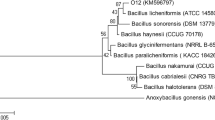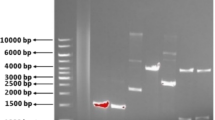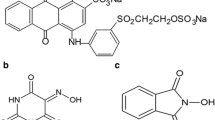Abstract
CotA protein is a component of the endospore coat of Bacillus subtilis and it exhibits the activities of laccase. CotA protein is known as CotA laccase. A CotA laccase gene from B. subtilis WD23 was cloned and expressed in Escherichia coli. The expressed CotA laccase was observed in an active form. The molecular weight of CotA laccase was estimated to be 67.5 kDa. Optimal laccase activity was detected at pH 7.2 and 45 °C with syringaldazine as substrate. The half-life of the laccase was 1.5 h at 80 °C at the optimum pH. Half of the laccase activity was lost after 8 h at 45 °C and pH 9.0. The CotA laccase exhibited high tolerance to acetone, petroleum ether, ethyl acetate and chloroform, like spore laccase. Purified CotA laccase was activated 157 % by Cu2+ and remained stable to Fe2+. The purified CotA laccase could decolorize 87 % of Remazol Brilliant Blue R (RBBR) and 81 % of Congo Red in 6 h in absence of any mediator.




Similar content being viewed by others
References
Baldrian P (2006) Fungal laccases—occurrence and properties. FEMS Microbiol Rev 30:215–242
Camarero S, Ibarra D, Martínez MJ, Martínez AT (2005) Lignin-derived compounds as efficient laccase mediators for decolorization of different types of recalcitrant dyes. Appl Environ Microbiol 71:1775–1784
Dubé E, Shareck F, Hurtubise Y, Daneault C, Beauregard M (2008) Homologous cloning, expression, and characterization of a laccase from Streptomyces coelicolor and enzymatic decolourisation of an indigo dye. Appl Microbiol Biotechnol 79:597–603
Enguita FJ, Martins LO, Henriques AO, Carrondo MA (2003) Crystal structure of a bacterial endospore coat component. A laccase with enhanced thermostability properties. J Biol Chem 278:19416–19425
Forootanfar H, Faramarzi MA, Shahverdi AR, Yazdi MT (2011) Purification and biochemical characterization of extracellular laccase from the ascomycete Paraconiothyrium variabile. Bioresour Technol 102:1808–1814
Giardina P, Faraco V, Pezzella C, Piscitelli A, Vanhulle S, Sannia G (2010) Laccases: a never-ending story. Cell Mol Life Sci 67:369–385
Guan ZB, Song CM, Zhang N, Zhou W, Xu CW, Zhou LX, Zhao H, Cai YJ, Liao XR (2014) Overexpression, characterization, and dye-decolorizing ability of a thermostable, pH-stable, and organic solvent-tolerant laccase from Bacillus pumilus W3. J Mol Catal B Enzym 101:1–6
Hadibarata T, Yusoff ARM, Kristanti RA (2012a) Decolorization and metabolism of anthraquionone-type dye by laccase of white-rot fungi Polyporus sp. S133. Water Air Soil Pollut 223:933–941
Hadibarata T, Yusoff ARM, Salmiati AA, Hidayat T, Kristanti RA (2012b) Decolorization of azo, triphenylmethane and anthraquinone dyes by laccase of a newly isolated Armillaria sp. F022. Water Air Soil Pollut 223:1045–1054
Hoshida H, Fujita T, Murata K, Kubo K, Akada R (2005) Copper-dependent production of a Pycnoporus coccineus extracellular laccase in Aspergillus oryzae and Saccharomyces cerevisiae. Biosci Biotechnol Biochem 69:1090–1097
Koschorreck K, Richter SM, Ene AB, Roduner E, Schmid RD, Urlacher VB (2008) Cloning and characterization of a new laccase from Bacillus licheniformis catalyzing dimerization of phenolic acids. Appl Microbiol Biotechnol 79:217–224
Lu L, Zhao M, Zhang BB, Yu SY, Bian XJ, Wang W, Wang Y (2007) Purification and characteriz ation of laccase from Pycnoporus sanguineus and decolorization of an anthraquinone dye by the enzyme. Appl Microbiol Biotechnol 74:1232–1239
Lu L, Zhao M, Liang SC, Zhao LY, Li DB, Zhang BB (2009) Production and synthetic dyes decolorization capacity of a recombinant laccase from Pichia pastoris. J Appl Microbiol 107:1149–1156
Lu L, Wang TN, Xu TF, Wang JY, Wang CL, Zhao M (2013) Cloning and expression of thermo-alkali-stable laccase of Bacillus licheniformis in Pichia pastoris and its characterization. Bioresour Technol 134:81–86
Majeau JA, Brar SK, Tyagi RD (2010) Laccases for removal of recalcitrant and emerging pollutants. Bioresour Technol 101:2331–2350
Mayer AM, Staples RC (2002) Laccase: new functions for an old enzyme. Phytochemistry 60:551–565
Miyazaki K (2005) A hyperthermophilic laccase from Thermus thermophilus HB27. Extremophiles 9:415–425
Mohammadian M, Fathi-Roudsari M, Mollania N, Badoei-Dalfard A, Khajeh K (2010) Enhanced expression of a recombinant bacterial laccase at low temperature and microaerobic conditions: purification and biochemical characterization. J Ind Microbiol Biotechnol 37:863–869
Nagai M, Sato T, Watanabe H, Saito K, Kawata M, Enei H (2002) Purification and characterization of an extracellular laccase from the edible mushroom Lentinula edodes, and decolorization of chemically different dyes. Appl Microbiol Biotechnol 60:327–335
Neifar M, Jaouani A, Ellouze-Ghorbel R, Ellouze-Chaabouni S (2010) Purification, characterization and decolorization ability of Fomes fomentarius laccase produced in solid medium. J Mol Catal B Enzym 64:68–74
Niladevi KN, Jacob N, Prema P (2008) Evidence for a halotolerant-alkaline laccase in Streptomyces psammoticus : purification and characterization. Process Biochem 43:654–660
Pozdnyakova NN, Rodakiewicz-Nowak J, Turkovskaya OV (2004) Catalytic properties of yellow laccase from Pleurotus ostreatus D1. J Mol Catal B 30:19–24
Quaratino D, Federici F, Petruccioli M, Fenice M, Dannibale A (2007) Production, purification and partial characterization of a novel laccase from the white-rot fungus Panus tigrinus CBS 577.79. Antonie Van Leeuwenhoek 91:57–69
Rodríguez Couto S, Toca Herrera JL (2006) Industrial and biotechnological applications of laccases: a review. Biotechnol Adv 24:500–513
Sharma P, Goel R, Capalash N (2007) Bacterial laccases. World J Microbiol Biotechnol 23:823–832
Telke AA, Kadam AA, Jagtap SS, Jadhav JP, Govindwar SP (2010) Biochemical characterization and potential for textile dye degradation of blue laccase from Aspergillus ochraceus NCIM-1146. Biotechnol Bioprocess Eng 15:696–703
Vianello F, Ragusa S, Cambria MT, Rigo A (2006) A high sensitivity amperometric biosensor using laccase as biorecognition element. Biosens Bioelectron 21:2155–2160
Wang CL, Zhao M, Lu L, Wei XD, Li TL (2011) Characterization of spore laccase from Bacillus subtilis WD23 and its use in dye decolorization. Afr J Biotechnol 10:2186–2192
Yang XQ, Zhao XX, Liu CY, Zheng Y, Qian SJ (2009) Decolorization of azo, triphenylmethane and anthraquinone dyes by a newly isolated Trametes sp. SQ01 and its laccase. Process Biochem 44:1185–1189
Zhang GQ, Wang YF, Zhang XQ, Ng TB, Wang HX (2010) Purification and characterization of a novel laccase from the edible mushroom Clitocybe maxima. Process Biochem 45:627–633
Zou YJ, Wang HX, Ng TB, Huang CY, Zhang JX (2012) Purification and characterization of a novel laccase from the edible mushroom Hericium coralloides. J Microbiol 50:72–78
Acknowledgments
This work was funded by the State Forestry Administration Project 948 (2012-4-03), National Natural Science Foundation (No.31170553, 30671702, 30170775), the Fundamental Research Funds for the Central Universities (No.DL12CA08) and Heilongjiang Postdoctoral Fund (No.LBH-Z11254).
Conflict of interest
We declare that we have no conflicts of interest.
Author information
Authors and Affiliations
Corresponding authors
Rights and permissions
About this article
Cite this article
Wang, C., Cui, D., Lu, L. et al. Cloning and characterization of CotA laccase from Bacillus subtilis WD23 decoloring dyes. Ann Microbiol 66, 461–467 (2016). https://doi.org/10.1007/s13213-015-1128-8
Received:
Accepted:
Published:
Issue Date:
DOI: https://doi.org/10.1007/s13213-015-1128-8




